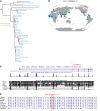Genetic predisposition to neuroblastoma results from a regulatory polymorphism that promotes the adrenergic cell state
- PMID: 37183825
- PMCID: PMC10178836
- DOI: 10.1172/JCI166919
Genetic predisposition to neuroblastoma results from a regulatory polymorphism that promotes the adrenergic cell state
Abstract
Childhood neuroblastomas exhibit plasticity between an undifferentiated neural crest-like mesenchymal cell state and a more differentiated sympathetic adrenergic cell state. These cell states are governed by autoregulatory transcriptional loops called core regulatory circuitries (CRCs), which drive the early development of sympathetic neuronal progenitors from migratory neural crest cells during embryogenesis. The adrenergic cell identity of neuroblastoma requires LMO1 as a transcriptional cofactor. Both LMO1 expression levels and the risk of developing neuroblastoma in children are associated with a single nucleotide polymorphism, G/T, that affects a GATA motif in the first intron of LMO1. Here, we showed that WT zebrafish with the GATA genotype developed adrenergic neuroblastoma, while knock-in of the protective TATA allele at this locus reduced the penetrance of MYCN-driven tumors, which were restricted to the mesenchymal cell state. Whole genome sequencing of childhood neuroblastomas demonstrated that TATA/TATA tumors also exhibited a mesenchymal cell state and were low risk at diagnosis. Thus, conversion of the regulatory GATA to a TATA allele in the first intron of LMO1 reduced the neuroblastoma-initiation rate by preventing formation of the adrenergic cell state. This mechanism was conserved over 400 million years of evolution, separating zebrafish and humans.
Keywords: Genetic variation; Genetics; Molecular genetics; Oncology.
Conflict of interest statement
Figures






Update of
-
Genetic Predisposition to Neuroblastoma Results from a Regulatory Polymorphism that Promotes the Adrenergic Cell State.bioRxiv [Preprint]. 2023 Mar 1:2023.02.28.530457. doi: 10.1101/2023.02.28.530457. bioRxiv. 2023. Update in: J Clin Invest. 2023 May 15;133(10):e166919. doi: 10.1172/JCI166919. PMID: 36909587 Free PMC article. Updated. Preprint.
Comment in
-
Back to the future: evolutionary biology reveals a key regulatory switch in neuroblastoma pathogenesis.J Clin Invest. 2023 May 15;133(10):e167824. doi: 10.1172/JCI167824. J Clin Invest. 2023. PMID: 37183823 Free PMC article.
References
-
- Zimmerman MW, et al. MYC drives a subset of high-risk pediatric neuroblastomas and is activated through mechanisms including enhancer hijacking and focal enhancer amplification. Cancer Discov. 2018;8(3):320–335. doi: 10.1158/2159-8290.CD-17-0993. - DOI - PMC - PubMed
Publication types
MeSH terms
Substances
Grants and funding
LinkOut - more resources
Full Text Sources
Medical
Molecular Biology Databases
Miscellaneous

